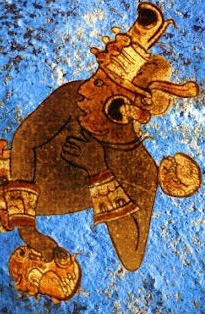Maya blue
| Maya blue | |
|---|---|

A warrior with azul Maya on the background
|
|
|
|
|
| Hex triplet | #73C2FB |
| sRGBB (r, g, b) | (115, 194, 251) |
| HSV (h, s, v) | (205°, 54%, 98%) |
| Source | http://www.colorhexa.com/73c2fb |
|
B: Normalized to [0–255] (byte) |
|
Maya blue (Spanish: azul maya) is a unique bright azure blue pigment manufactured by cultures of pre-Columbian Mesoamerica, such as the Maya and Aztec.
The Maya blue pigment is a composite of organic and inorganic constituents, primarily indigo dyes derived from the leaves of añil (Indigofera suffruticosa) plants combined with palygorskite, a natural clay which, mysteriously, is not known to exist in abundant deposits in Mesoamerica. Smaller trace amounts of other mineral additives have also been identified.
Maya blue first appeared around 800, and it was still used in the 16th century in several Convents of Colonial Mexico, notably in the paintings of the Indian Juan Gerson in Tecamachalco. These paintings are a clear example of the combination of Indian and European techniques sometimes known as Arte Indocristiano. After that, the techniques for its production were lost in Mexico, but in Cuba there are examples from as late as 1830.
Despite time and the harsh weathering conditions, paintings colored by Maya blue have not faded over time. More remarkably, the color has resisted chemical solvents and acids such as nitric acid. Recently, its resistance against chemical aggression (acids, alkalis, solvents, etc.) and biodegradation was tested, and it was shown that Maya blue is an extremely resistant pigment, but it can be destroyed using very intense acid treatment under reflux.
The chemical composition of the compound was determined by powder diffraction in the 1950s and was found to be a composite of palygorskite and indigo, most likely derived from the leaves of the añil. An actual recipe to reproduce Maya blue pigment was published in 1993 by a Mexican historian and chemist, Constantino Reyes-Valerio. The combination of different clays (palygorskite and montmorillonite), together with the use of the leaves of the añil and the actual process is described in his paper. Reyes-Valerio's contributions were possible due to his combined background of history and chemistry, through a thorough revision of primary texts (Sahagun, Hernandez, Jimenez, and others), microscopic analysis of the mural paintings and fourier transform infrared spectroscopy.
...
Wikipedia
